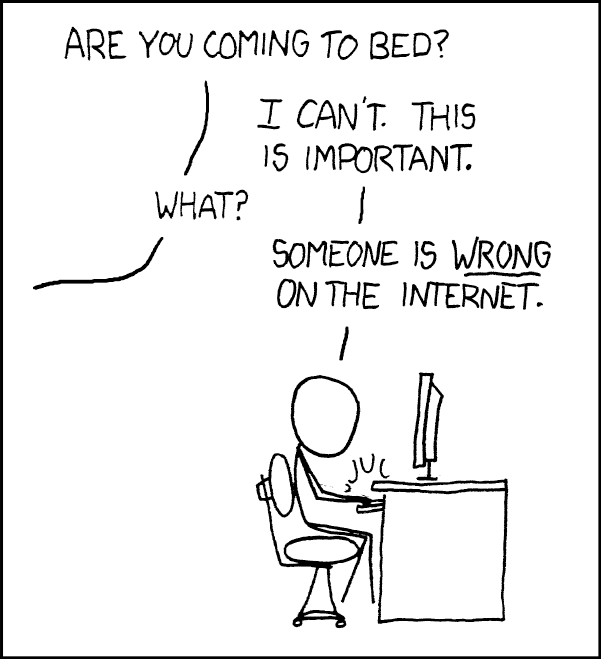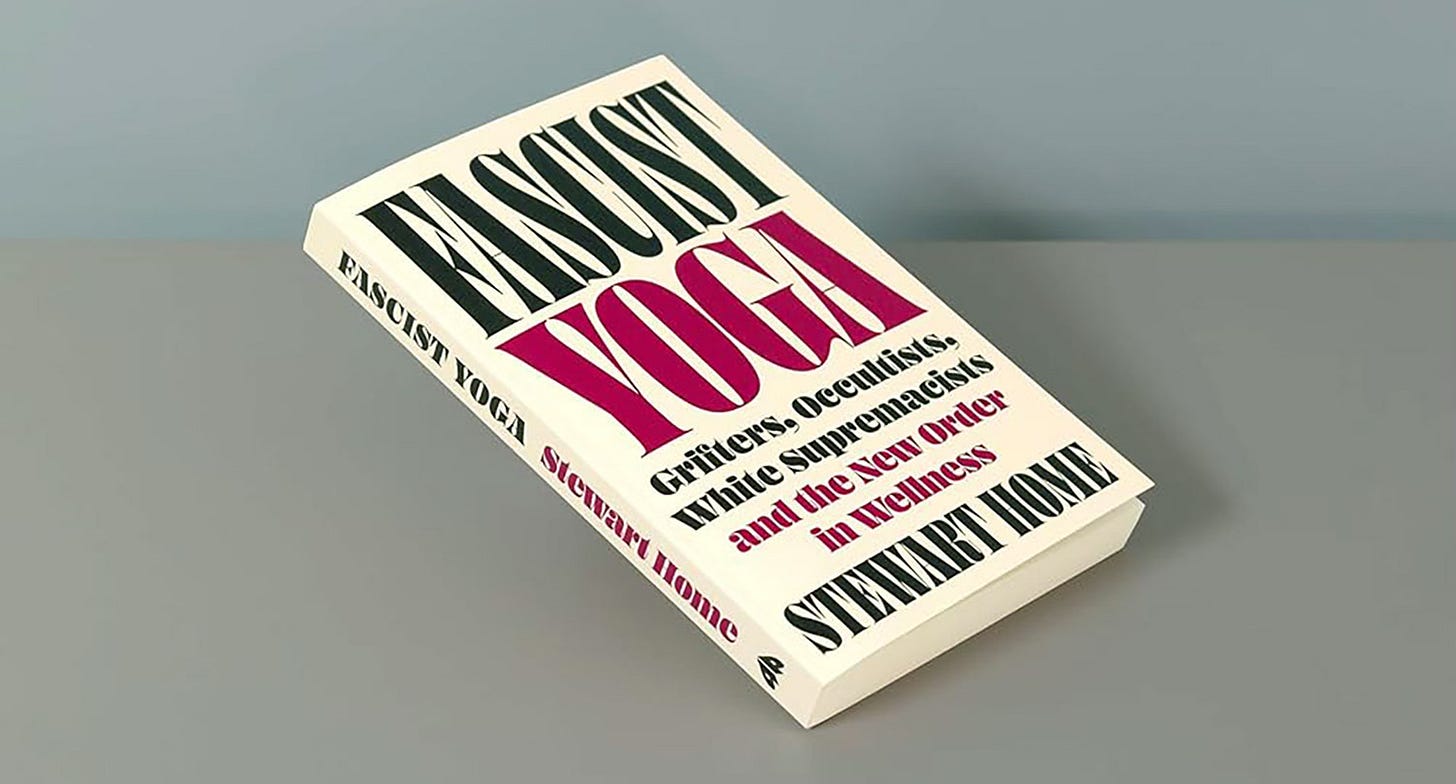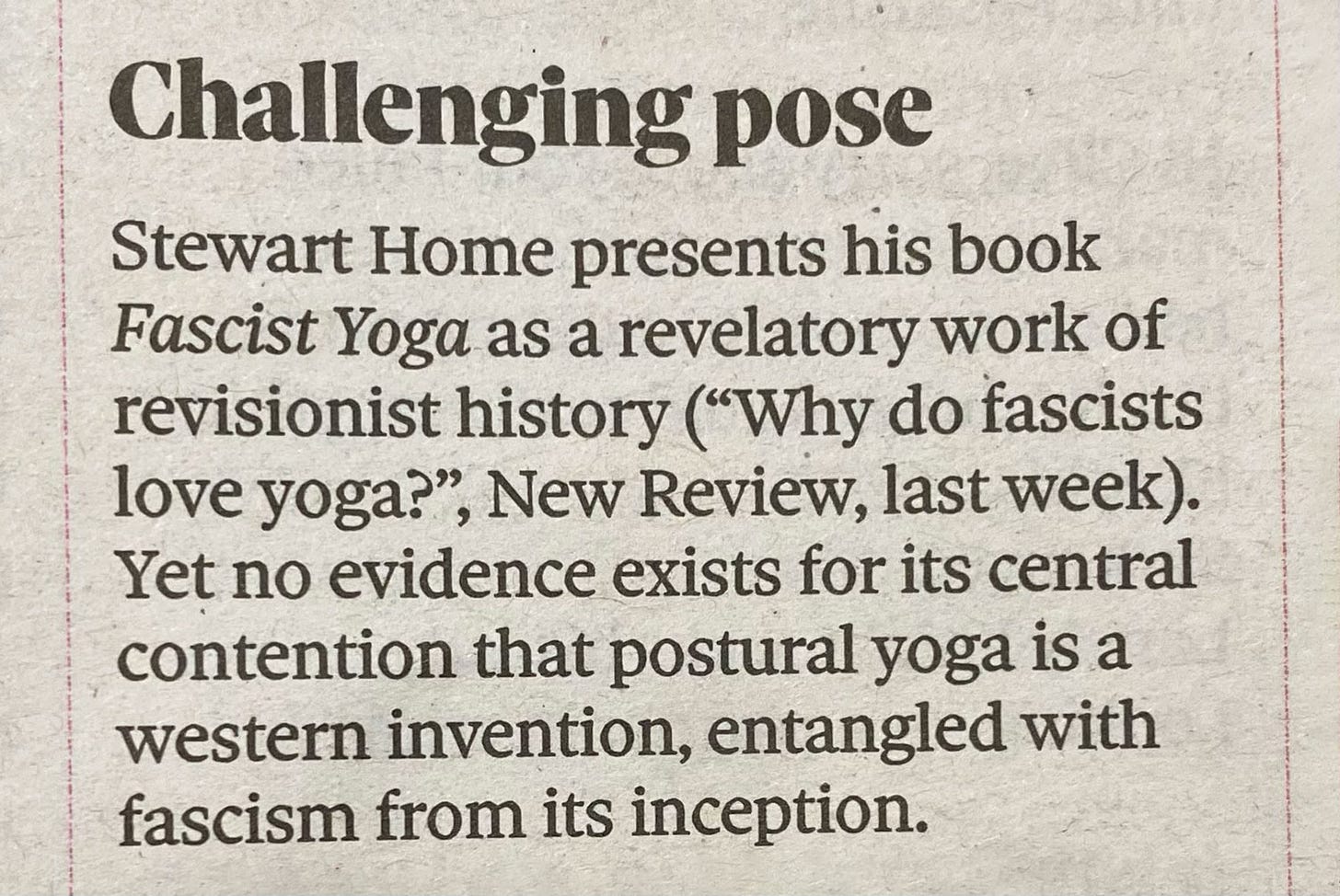Proving Brandolini's Law
How "bullshit asymmetry" fuels publishing hype
Another day, another article about Fascist Yoga… I’ve already reviewed the book here (and critiqued it elsewhere), but there’s more to be said about the media’s embrace of its misleading thesis, along with the story of how it got printed.
Of course, discussing it risks helping it sell, but it’s a fascinating case study. Give or take a few caveats, the author – Stewart Home – has received glowing coverage in the Times, the Telegraph, Prospect, the Observer, Die Welt and the New York Review of Books. Even right-wingers at the European Conservative, who lament the modern tendency to label them fascists, praised “the book’s careful and specialist scholarship”.
However, expert scholars don’t share this opinion. The publisher asked one – Mark Singleton – to read Home’s proposal for Fascist Yoga in 2023. Singleton replied that the book was “entirely lacking in careful critical analysis [and] historical basis”. Since this verdict had no impact on the contents – much of the text has changed very little from its first incarnation as a series of blog posts – Singleton agreed to let me quote it.
Apparently, a title combining two buzzwords was marketing manna too good to resist. It wrote its own sales pitch, which headlines have fog-horned. “Namaste, fascists! The racist history of yoga”, screamed the Times. The Telegraph plumped for: “Why yoga is a breeding ground for fascists”, while the Observer asked: “Why do fascists love yoga?”
A serious response would require enough knowledge to realise the book doesn’t answer this question. Since the Observer failed to do that, I wrote to the editor:
Stewart Home presents Fascist Yoga as a revelatory work of revisionist history. Yet no evidence exists for its central contention that postural yoga is a Western invention, entangled with fascism from its inception.
Had Miles Ellingham interviewed scholars as well as the author (“Why do fascists love yoga?”, New Review, last week), he might not have mistakenly written that “the fascism-yoga Venn diagram” was “just a broad circle with two slim crescents on either side” before 1945.
He might also have been less credulous about Home’s assertions regarding Pierre Bernard, an American showman portrayed as the creator of modern postural practice. No academic expert would agree with Home’s claim that Bernard fabricated his Indian teacher, let alone that this guru’s existence “is not evidenced by Bernard’s biographer”, as the article suggests.
Home lifts swathes of his chapter on Bernard from the work of this biographer, Robert Love, whose research is then distorted to attack and insult him – as Home does other authors including Georg Feuerstein and Richard Rosen. Meanwhile, Home’s thesis of an intimate link between interwar fascism and postural yoga rests on three examples with negligible influence. He also seems oblivious to scholarship about the evolution of postural yoga in Indian traditions.
None of this is surprising – the book’s clear intention is to shock and sell copies. That a radical publisher should disregard the facts to enable this grift is disappointing. For The Observer to assist in the process even more so. You’ve been played.
The paper published an edited version of this on Sunday, August 3, 2025, which kept the first paragraph and bowdlerised the rest.
That was hardly unexpected. It reminded me of efforts 20 years ago to publish articles that criticised journalists. Their understandable reluctance to commission me to do so led to me printing a fake edition of the Financial Times, which opined: “The views that frame a story shape its message, and whoever constructs this frame dictates the news.”
Stewart Home, billed on the cover of Fascist Yoga as “a legend of counterculture”, has spent decades in the shadows of better-known peers. A fawning profile from 2002 in the London Review of Books said: “I really don’t think anyone who is at all interested in the study of literature has any business not knowing the work of Stewart Home”. Yet the author of this article seemed somewhat baffled that more people didn’t:
“I assumed that Home would shortly be bought up by Picador or someone and promoted like the late Kathy Acker was in the 1980s, as an urchin-cropped token avant-gardist, with life-size cardboard cut-outs and appearances on the Late Show as then was. I am still surprised it didn’t happen, and I would imagine that Home, who always makes a point of stressing how much he enjoys media attention, expensive restaurants and so on, was surprised as well. (The press release accompanying 69 Things assiduously lists the currently celebrated names with which his work has been associated: Wolfgang Tillmans; Tracey Emin; Janet Street-Porter; Tate Modern; the V&A; the KLF.)”
Writing in the Guardian two years later, the KLF’s Bill Drummond suggested to Home: “One of the fundamental differences between us is that you like to make the world a better place by spreading lies while I like to try and do it by spreading truths.” To which Home countered: “You should try lying more, Bill. It works better.”
Although the piece was headlined “The liar”, Home’s apparent admission was cloaked in a layer of what U.S. officialdom calls “plausible deniability”, since Drummond also added: “I’ll try lying when I write up your answers to some of my questions”.
Mark Singleton’s pre-publication comments on Fascist Yoga sensed this penchant for manipulative mind-games. “My hunch is that it will function by scattergun theory and fast-moving argument that will be hard to follow and even harder to refute,” he wrote to Home’s publisher, Pluto Press, “as in Brandolini’s Bullshit Law”.
That dictum, coined by the Italian programmer Alberto Brandolini, is also known as the “bullshit asymmetry principle”. As originally stated on Twitter in 2013, it says “the amount of energy needed to refute bullshit is an order of magnitude bigger than [that required] to produce it”. A deck of slides on the principle warns “some battles cannot be won”, so the recommended action is to “avoid them”. After all, Brandolini notes, citing a 2008 cartoon: “Somebody is always going to be wrong on the Internet”.

Some authors might not feel so inclined to ignore Home’s mangling of their efforts. One of those mentioned already is Robert Love, whose biography of Pierre Bernard is widely cited by specialists, including Kate Imy, Paul Hackett and Hugh Urban. Home chides them for doing so, then ransacks their writing for cherry-picked facts to frame Fascist Yoga. He also misreads Singleton’s work to claim postural practice was cobbled together from “nineteenth-century occidental circus acts and gymnastics”.
Singleton warned the publisher in 2023 that Home’s book “seems entirely derivative” yet “it is presented as if it is the author’s original research”. However, that assessment was not a deterrent to Pluto Press, which describes itself as “one of the oldest radical publishing houses in the world”. Having launched Fascist Yoga with multiple ads on social media, it’s now hawking merch “for the discerning lefty yogi”.
For a publisher to focus on sales is unsurprising – bestsellers help to subsidise less marketable titles. But Pluto’s list includes media activists, so one might have hoped they wouldn’t hoodwink the press with deceptive blurb saying: “Home sweeps away the half-truths to tell a new origin story of the world’s first modern yogi”.
When I emailed Pluto’s publicist my review, he replied: “We appreciate the critical engagement! Great to get a conversation brewing.” In other words, thanks for helping me to do my job of attracting attention. That’s also the mission of journalists urged to fill screens with viral content. Hence, some seized the chance to file clickable stories about fascist yogis. To borrow a phrase from Private Eye, trebles all round!
* To explore yoga’s history in depth, join me online for The Path of Knowledge *
If you like what you find here, and want to support it, please consider paying to subscribe…




what a troublesome nettle. Thank you for covering it so astutely.